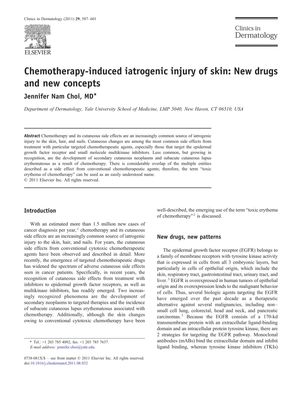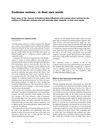Chemotherapy-Induced Iatrogenic Injury of Skin: New Drugs and New Concepts
October 2011
in “
Clinics in Dermatology
”
chemotherapy epidermal growth factor receptor inhibitors EGFR inhibitors small molecule multikinase inhibitors toxic erythema of chemotherapy TEC papulopustular eruption oral minocycline tetracycline Hand-Foot Skin Reaction HFSR secondary cutaneous neoplasms subacute cutaneous lupus erythematosus SCLE minocycline

TLDR New chemotherapy drugs cause skin side effects, but treatments like minocycline and tetracycline can help reduce them.
The document from 2011 examines the skin-related side effects of chemotherapy, particularly those caused by targeted chemotherapeutic agents such as epidermal growth factor receptor (EGFR) inhibitors and small molecule multikinase inhibitors. It introduces the term "toxic erythema of chemotherapy" (TEC) for the overlapping skin side effects from conventional chemotherapy. EGFR inhibitors are associated with a common papulopustular eruption affecting 45% to 90% of patients, which can impact quality of life and treatment adherence. Studies mentioned include one with 48 patients where oral minocycline reduced lesion counts, another with 61 patients where tetracycline lessened rash severity, and a phase II trial (STEPP) with 95 patients where preemptive treatment reduced the incidence of grade 2 or greater skin toxicities by over 50%. The document also discusses Hand-Foot Skin Reaction (HFSR), secondary cutaneous neoplasms, and chemotherapy-induced subacute cutaneous lupus erythematosus (SCLE), emphasizing the need for regular skin checks and more randomized controlled trials to establish evidence-based treatment guidelines.



